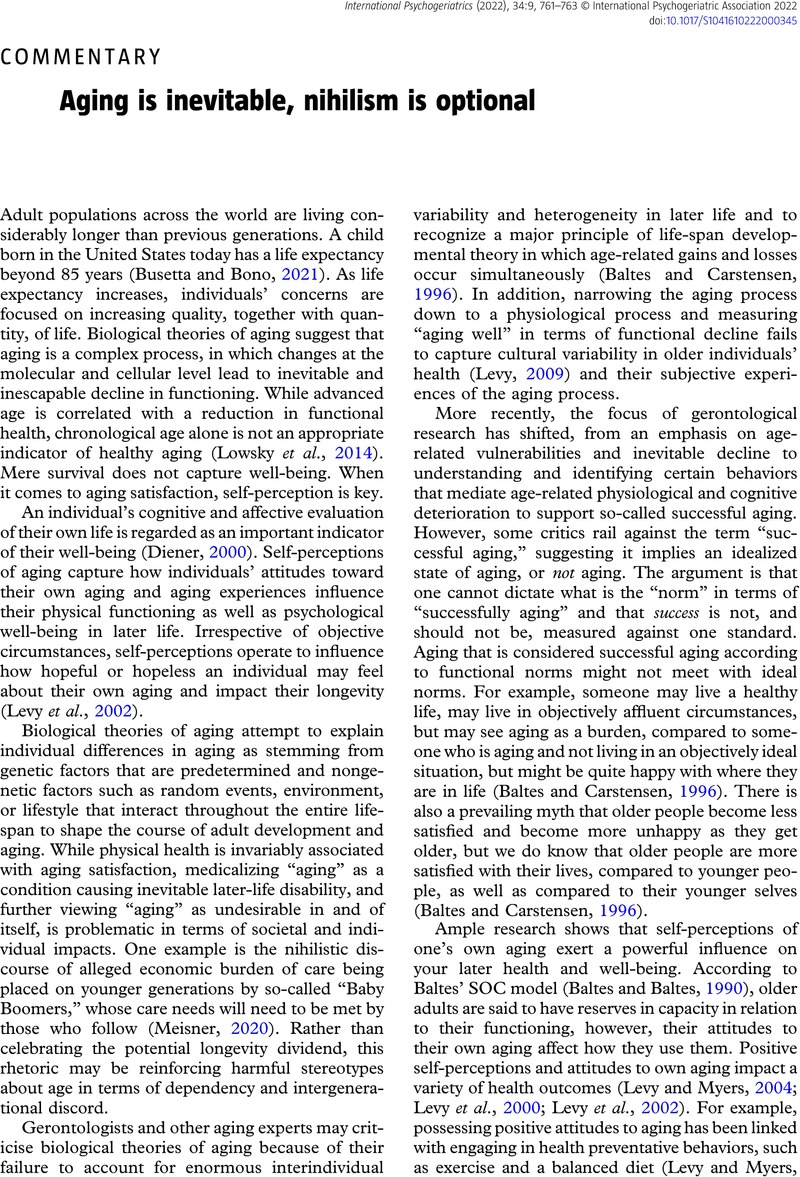No CrossRef data available.
Article contents
Aging is inevitable, nihilism is optional
Published online by Cambridge University Press: 26 August 2022
Abstract
An abstract is not available for this content so a preview has been provided. Please use the Get access link above for information on how to access this content.

- Type
- Commentary
- Information
- International Psychogeriatrics , Volume 34 , Special Issue 9: Issue Theme: Non-Medical Social Determinants of Health , September 2022 , pp. 761 - 763
- Copyright
- © International Psychogeriatric Association 2022
References
Ayalon, L. (2020). There is nothing new under the sun: ageism and intergenerational tension in the age of the COVID-19 outbreak. International Psychogeriatrics, 32, 1221–1224. DOI 10.1017/S1041610220000575.CrossRefGoogle ScholarPubMed
Baltes, P. B. and Baltes, M. M. (1990). Psychological perspectives on successful aging: the model of selective optimization with compensation. In: , P. B. and Baltes, M. M. (Eds.), Successful Aging: Perspectives from the Behavioral Sciences (pp. 1–34). New York: Cambridge University Press. DOI 10.1017/CBO9780511665684.003.CrossRefGoogle Scholar
Baltes, M. M. and Carstensen, L. L. (1996). The process of successful ageing. Ageing & Society, 16, 397–422. DOI 10.1017/S0144686X00003603.CrossRefGoogle Scholar
Brothers, A., Gabrian, M., Wahl, H. W. and Diehl, M. (2019). A new multidimensional questionnaire to assess awareness of age-related change (AARC). The Gerontologist, 59, e141–e151. DOI 10.1093/geront/gny006.CrossRefGoogle Scholar
Busetta, A. and Bono, F. (2021). Demographic aspects of aging. In: Carudo, C. and Candore, G. (Eds.), Human Aging: From Cellular Mechanisms to Therapeutic Strategies (pp 13–34). Cambridge, MA: Academic Press.CrossRefGoogle Scholar
Cohn-Schwartz, E. and Ayalon, L. (2020). Societal views of older adults as vulnerable and a burden to society during the COVID-19 outbreak: results from an Israeli nationally representative sample. The Journals of Gerontology Series B, 1–5. DOI 10.1093/geronb/gbaa150.Google Scholar
Diehl, M. K. and Wahl, H. W. (2010). Awareness of age-related change: examination of a (mostly) unexplored concept. Journals of Gerontology Series B: Psychological Sciences and Social Sciences, 65, 340–350. DOI 10.1093/geronb/gbp110.CrossRefGoogle Scholar
Diener, E. (2000). Subjective well-being. The science of happiness and a proposal for a national index. American Psychologist, 55, 34–43. DOI 10.1037/0003-066X.55.1.34.CrossRefGoogle Scholar
Fawsitt, F. and Setti, A. (2017). Extending the stereotype embodiment model: a targeted review. Translational Issues in Psychological Science, 3, 357–369. DOI 10.1037/tps0000136.CrossRefGoogle Scholar
Kaspar, R., Gabrian, M., Brothers, A. F., Wahl, H.-W. and Diehl, M. K. (2019). Measuring awareness of age-related change: development of a 10-Item short form for use in large- scale surveys. The Gerontologist, 59, e130–e140. DOI 10.1093/geront/gnx213.CrossRefGoogle ScholarPubMed
Levy, B. R., Hausdorff, J. M., Hencke, R. and Wei, J. Y. (2000). Reducing cardiovascular stress with positive self-stereotypes of aging. The Journals of Gerontology Series B: Psychological Sciences and Social Sciences, 55, P205–P213. DOI 10.1093/geronb/55.4.P205.CrossRefGoogle ScholarPubMed
Levy, B. R. and Myers, L. M. (2004). Preventive health behaviors influenced by self-perceptions of aging. Preventive Medicine, 39, 625–629. DOI 10.1016/j.ypmed.2004.02.029.CrossRefGoogle ScholarPubMed
Levy, B. (2009). Stereotype embodiment: a psychosocial approach to aging. Current Directions in Psychological Science, 18, 332–336. DOI 10.1111/j.1467-8721.2009.01662.x.CrossRefGoogle ScholarPubMed
Levy, B. R., Slade, M. D., Kunkel, S. R. and Kasl, S. V. (2002). Longevity increased by positive self-perceptions of aging. Journal of Personality and Social Psychology, 83, 261–270. DOI 10.1037//0022-3514.83.2.261.CrossRefGoogle ScholarPubMed
Lowsky, D. J., Olshansky, S. J., Bhattacharya, J. and Goldman, D. P. (2014). Heterogeneity in healthy aging. Journals of Gerontology Series A: Biomedical Sciences and Medical Sciences, 69, 640–649. DOI 10.1093/gerona/glt162.CrossRefGoogle ScholarPubMed
Meisner, B. A. (2020). Are You OK, Boomer? Intensification of ageism and intergenerational tensions on social media amid COVID-19. Leisure Sciences, 43, 1–6. DOI 10.1080/01490400.2020.1773983.Google Scholar
Pachana, N. A., Beattie, E., Byrne, G. J. and Brodaty, H. (2020). COVID-19 and psychogeriatrics: the view from Australia. International Psychogeriatrics, 32, 1135–1141. DOI 10.1017/S1041610220000885.CrossRefGoogle ScholarPubMed
Sabatini, S. et al. (2022). Exploring awareness of age-related changes among over 50s in the UK: findings from the PROTECT study. International psychogeriatrics, 34, 789–803. DOI 10.1017/S104161022100123X.CrossRefGoogle ScholarPubMed
Scott, T. L., Kugelman, M. and Tulloch, K. (2019). How medical professional students view older people with dementia: implications for education and practice. PLoS ONE, 14, e0225329. DOI 10.1371/journal.pone.0225329.CrossRefGoogle ScholarPubMed
Swift, H. J., Abrams, D., Lamont, R. A. and Drury, L. (2017). The Risks of Ageism Model: how ageism and negative attitudes toward age can be a barrier to active aging. Social Issues and Policy Review, 11, 195–231. DOI 10.1111/sipr.12031.CrossRefGoogle Scholar


